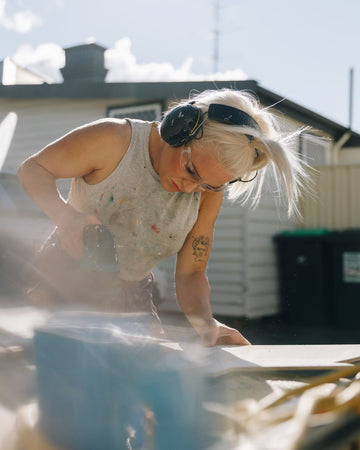
About Misha …
Misha Harrison was born in Wollongong, NSW Australia in 1990.She studied fine arts at Wollongong TAFE before undertaking a Bachelor of Creative Arts, majoring in sculpture and textiles. She completed her degree in 2015 graduating within the top five precent of her faculty. In 2016, Misha completed her Honours degree, graduating in the first class.
Harrison has won the NAVA Graduating Student Award, the Hazelhurst Artist in Residence, the Liz Jeneid Textile Prize and was selected to exhibit in the North Sydney Art Prize in 2017. Throughout 2018 and 2019 Misha was the resident artist at the Barracks Studios in Thirroul. From 2020 Harrison has been exhibiting with Sydney Road Gallery, where she has had two solo exhibitions and numerous group shows. Harrison has also exhibited at Corner Store Gallery in Orange. She recently won the Jumbled Art Superstar Award in 2022.
Harrisons practise explores materiality and process through the genre of still life. Each artwork comprises of intricately hand cut, painted and embroidered plywood. The artworks translate real life arrangements of flowers, drapery and objects into three-dimensional artworks that combine sculpture, painting and textile practices.
In a world of the readymade and mass produced, the importance of the handmade is crucial to Harrison’s practice- she relates to the core notions of the Art and Craft Movement of the mid 19th century channeling the concept that mass produced and readymade items lack soul. Harrison expresses her soul through her detailed and meticulous craftsmanship in wood, embroidery and painting.
Dimension, form, texture and colour are each important components of Harrisons artworks. Plywood- (aesthetically mundane in its original form – commonly used in building and craft) is transformed into elaborate assemblages of colourful shapes, patterns and textures. Cutting, carving, sanding, painting and gluing are some of the labour-intensive exercises involved in her process. These woodworking processes- (traditionally seen as ‘masculine’) are juxtaposed with the use of embroidery and textiles that echo notions of femininity. The uniting of both the masculine and feminine mirrors the new age in society where there is a paradigm shift in gender roles.
Reminiscent of a jigsaw puzzle, every different piece the artworks has been drawn onto the wood, cut, painted and finished to fit into its place. The ‘puzzle’ resonates Harrisons process- chaotic but methodical, disordered but intentional. Piece by handcrafted piece the artwork reveals itself through her process. The process of Harrison’s art is just as important as the finished result. Harrison’s art making defies the constraints of painting and sculpture, masculine and feminine.
